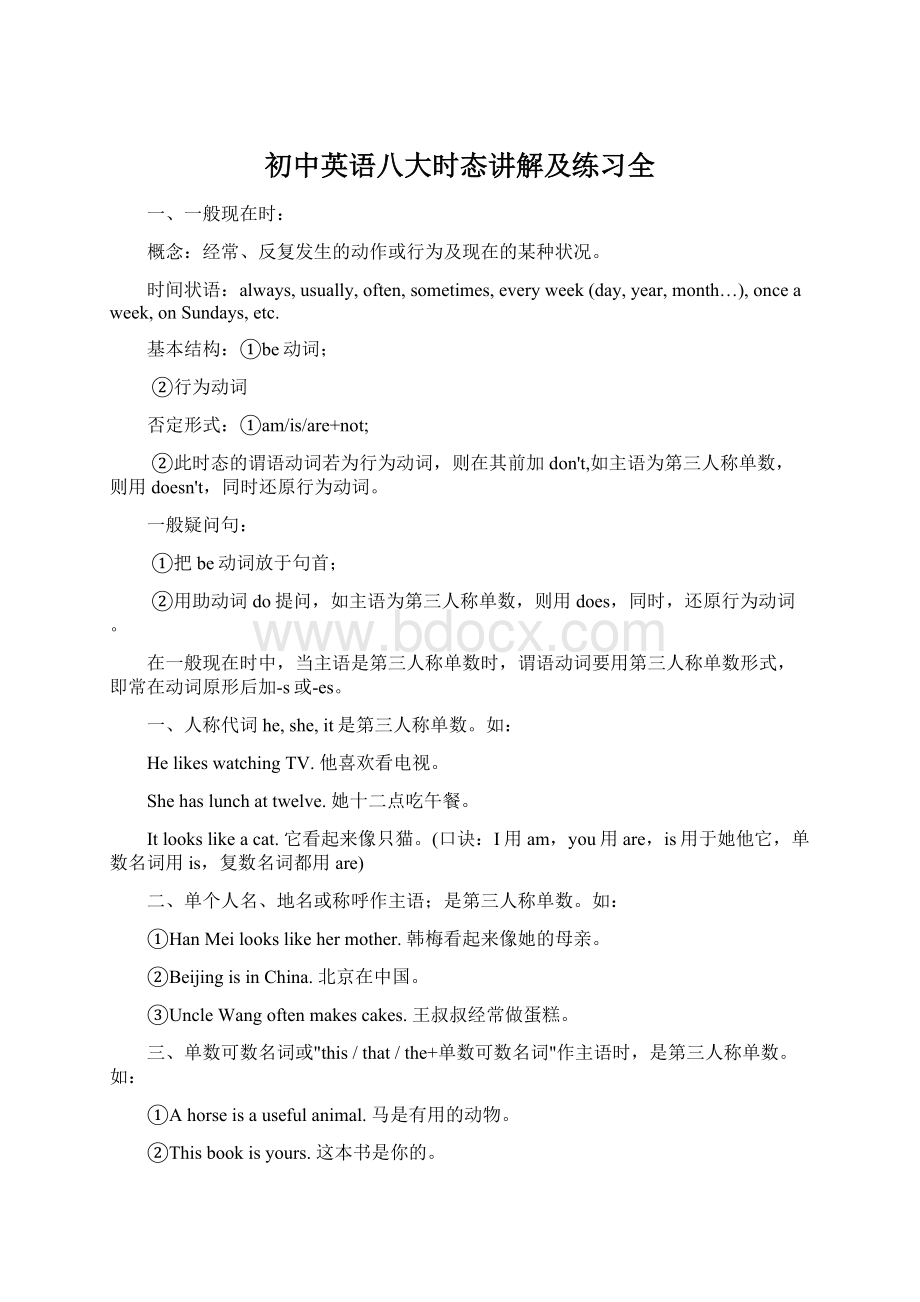初中英语八大时态讲解及练习全Word格式.docx
《初中英语八大时态讲解及练习全Word格式.docx》由会员分享,可在线阅读,更多相关《初中英语八大时态讲解及练习全Word格式.docx(29页珍藏版)》请在冰豆网上搜索。

作主语时,是第三人称单数。
①Ahorseisausefulanimal.马是有用的动物。
②Thisbookisyours.这本书是你的。
四、不定代词someone,somebody,nobody,everything,something等及指示代词this,that作主语时,是第三人称单数。
①Everyoneishere.大家到齐了。
②Thereissomethingwrongwiththewatch.这块手表有毛病。
五、不可数名词作主语时为第三人称单数。
①Themilkisintheglass.牛奶在玻璃杯里。
②Thebreadisverysmall.那面包很小。
六、当数字或字母作主语时,看作第三人称单数。
①"
6"
isaluckynumber."
是个吉利数字。
【练习】
一、单选
1Jenny____inanoffice.Herparents____inahospital.
AworkworksBworksworkCworkareworkingDisworkingwork
2Oneoftheboys_____ablackhat.
AhaveBthereisCthereareDhas
3Wewillgoshoppingifit____tomorrow.
Adon'
trainBdidn'
trainCdoesn'
trainDisn'
train
4Hesaidthesun____intheeastand____inthewest.
Arose;
setBrises;
setsCrises,setDrise;
sets
5WangMei____musicandoften____tomusic.
Alike;
listenBlikes;
listensClike;
arelisteningDliking;
listen
6Jenny____Englisheveryevening.
AhasstudyBstudiesCstudyDstudied
二、填空
1IcantakeLiMingtherewhenhe_____(come)tovisit.
2_____yoursister_____(know)English?
3Herhome_______________(远离)herschool.
4Thepot_____(notlook)likeyoursverymuch.
5Where_____you____(have)luncheveryday?
6Who_____(想要)togoswimming?
7______she_____(do)thehouseworkeveryday?
8JennyandDannyusually______(play)gamesintheafternoon.
二、一般过去时:
过去某个时间里发生的动作或状态;
过去习惯性、经常性的动作、行为。
ago,yesterday,thedaybeforeyesterday,lastweek(year,night,month…),in1989,justnow,attheageof5,oneday,longlongago,onceuponatime,etc.
一般过去时的结构(可分三类不同的结构)
1.Be动词的一般过去时在没有实义动词的句子中使用be动词,amis的过去式为was;
are的过去式为were
肯定句式:
主语+be(was,were)+其它.
否定句式:
主语+be(was,were)+not+其它.
Be(was,were)+主语+其它?
注:
在这种构成中,be动词有人称和数的变化,即要根据主语选用was/were。
Be动词分为单数和复数,was是表示单数,were是表示复数。
2.实义动词的一般过去时态肯定句要使用动词的过去式,否定句和疑问句要使用助动词do和does的过去式did.
主语+动词(过去式)+其它
否定句式:
主语+didn’t+动词(原形)+其它【didnot=didn’t】
Did+主语+动词(原形)+其它【do,does的过去时均为did】?
注:
1.did和didn’t是构成一般过去时的助动词,其特点是要在其后跟动词的原形。
2.实意动词do的一般过去时
Idomyhomeworkeveryday.(用yesterday改写句子)
Ididmyhomeworkyesterday.
Ididn’tdomyhomeworkyesterday.(否定句)
Didyoudoyourhomeworkyesterday?
Yes,Idid./No,Ididn’t.(一般疑问句)
3.情态动词的一般过去时态含有情态动词的一般过去时与含有Be动词的一般过去时,是十分相似,请注意观察。
主语+情态动词+其它
主语+情态动词+not+其它.
情态动词+主语+其它?
情态动词的过去式:
can→could,may→might,must→must,will-would,should-should。
4.特殊疑问句式:
特殊疑问词+be过去式+主语+其他?
特殊疑问词+情态助动词过去式+主语+动词原形+其他?
特殊疑问词+do/does过去式+主语+动词原形+其他?
Whatwasyourformername?
你以前叫什么名字?
WhywashelateforschoollastMonday?
上星期一他为什么迟到?
Whatcouldshedotwentyyearsago?
20年前她能做什么?
规则动词的过去式
1.一般情况下,在动词原形后面加-ed。
look→lookedplay→playedstart→startedvisit→visitedpull-pulled,cook-cooked
2.以不发音e结尾的动词,在词尾直接加-d。
live→liveduse→usedtaste-tasted
3.以“辅音字母+y”结尾的动词,先将y改为i,再加–ed。
study→studiedtry→triedfly→flied
4.以重读闭音节(即辅音+元音+辅音)或r音节结尾,末尾只有一个辅音字母的动词,要先双写这个辅音字母后,再加–ed。
stop→stoppedplan→plannedstop-stoppedprefer→preferred
5.不规则动词的过去式需特殊记忆。
如:
am(is)-was,are-were(是),become_became(成为)go-went(走)
基本用法
①表示过去某个特定时间发生的动作或存在的状态。
Hesuddenlyfellilllastnight.他昨晚突然病倒了。
②表示过去的习惯性或经常发生的动作
Shewenttothecinemaonceamonthwhenshewasatalkedbytheriverside.我在乡下时经常在河边散步。
③叙述过去连续发生的一件件事
Shegotupearly,fetchedwater,cleanedtheroomandthenwentoutforawalk.她早早起床,提水,打扫房间然后出去散步。
一、请用正确动词形式填空
1.He(live)inWuxitwoyearsago.
2.Thecat(eat)abirdlastnight.
3.We(have)apartylastHalloween.
4.Nancy(pick)uporangesonthefarmlastweek.
5.I(make)amodelshipwithMikeyesterday.
6.They(play)chessintheclassroomlastPElesson.
7.Mymother(cook)anicefoodlastSpringFestival.
8.Thegirls(dance)atthepartylastnight.
9.I(watch)acartoononSaturdaylastweek.
10.______you_______(visit)yourrelativeslastSpringFestival?
11.______he_______(fly)akiteonSunday?
Yes,he______.
12.GaoShan_______(put)upthepicturelastnight.
13.I____________(sweep)theflooryesterday.
14.What______she_______(find)inthegardenlastmorning?
15.Herfather_______(read)anewspaperlastnight.
16.Mike_________________(notgo)tobeduntil12o’clocklastnight.
17.Ilistenedbut___________(hear)nothing.
18.Howmanypeople________(be)thereinyourclasslastterm?
二、按要求变换句型。
1.Frankreadaninterestingbookabouthistory.(一般疑问句)
_______Frank_______aninterestingbookabouthistory?
2.Hecleanedhisroomjustnow..(划线提问)What________he_______?
3.ThomasspentRMB10onthisbook.(否定句)
Thomas______________RMB10onthisbook.
4.Myfamilywenttothebeachlastweek.(划线提问)
________________________family_______lastweek?
1.I_________(have)anexcitingpartylastweekend.
2._________she_________(practice)herguitaryesterday?
No,she_________.
3.What________Tom________(do)onSaturdayevening?
He________(watch)TVand__________(read)aninterestingbook.
4.Theyall_________(go)tothemountainsyesterdaymorning.
5.She_________(notvisit)herauntlastweekend.
She________(stay)athomeand_________(do)somecleaning.
6.When________you_________(write)thissong?
I__________(write)itlastyear.
7.Myfriend,Carol,________(study)forthemathtestand________(practice)Englishlastnight.
8.________Mr.Li__________(do)theprojectonMondaymorning?
Yes,he_________.
9.How_________(be)Jim'
sweekend?
It_________(benot)bad.
10.________(be)yourmotherasalesassistantlastyear?
No.she__________.
三、现在进行时:
表示现阶段或说话时正在进行的动作及行为。
构成:
be+现在分词。
be应为助动词,应与主语的人称和数保持一致。
【注】动词现在分词的变化规则
1.
一般情况下,直接在动词后加-ing,如:
work
-
working
study
studying
2.
动词以不发音的-e结尾,要去-e加-ing,如:
make
making
dance
dancing
3.
重读闭音节的动词,要双写词尾字母,再加-ing,如:
put
putting
begin
beginning
4.
以-ie结尾的动词,把-ie变成y再加-ing,如:
lie
lying
tie
tying
写出下列动词的现在分词形式
dance______shop_______
play______________
speak_______have
_______
________
write_______take________
study________
sit________sing________
swim________
lie________
变化:
主语+be(am,is,are)+现在分词+其它.
主语+be(am,is,are)+not+现在分词+其它.
Be(am,is,are)+主语+现在分词+其它?
特殊疑问句:
疑问词+be(am,is,are)+主语+现在分词+其它?
对现在进行时的特殊疑问句的回答,它不可以用Yes或No直接作答,要根据实际情况回答。
用法(包括高级用法):
1,表示说话时正在进行或发生的动作。
Pleasedon'
tmakesomuchnoise.I'
mwritingacomposition.不要吵闹。
我正在写作文。
Let'
ssetoff.Itisn’trainingnow.咱们出发吧。
现在不下雨了。
这类情况常与now现在,atthepresent现在,atthemoment现在,today今天,thisweek这个星期,thisyear今年等时间状语连用。
有时通过上下文可以判断出应采用何种时态,如:
It'
sfouro'
clockintheafternoon.Thechildrenareplayingfootballonthesportsground.现在是下午四点。
孩子们在操场上踢足球。
Hurryup!
Weareallwaitingforyou.快点!
我们大家都等着你。
Look!
Theyarereadingoverthereunderthetree.看!
他们在那边的树底下看书。
Listen!
Sheissingingintheroom.听!
她在房间里唱歌。
WhereisKate?
Sheisreadingintheroom.凯特在哪里?
她在房间里看书。
Whyareyoucrying?
Issomethingwrong?
为什么哭呢?
有什么不对?
2,表示现阶段正在进行而说话时不一定在进行的动作。
Weareworkinginafactorythesedays.这几天我们在一家工厂工作。
Theyarecompilingadictionary.他们在编一本词典。
这类情况常与today今天,thisweek这个星期,thisevening今天晚上,thesedays现在、目前等时间状语连用。
3,在口语中表示主语计划将要作的动作。
TheyareleavingforNewYorktomorrow.明天他们将要动身前往纽约。
Isyourbrotherdepartingsoon?
你的兄弟很快就要启程吗?
这类情况常与come来,go去,leave离开,depart离开,arrive到达,stay逗留,start开始等动词连用。
所用的动词必须是动作而不是状态,主语必须是人。
4,现在进行时与always等副词连用时带有感情色彩。
He'
salwaysquarrellingwithothers.他老喜欢跟别人吵架。
Sheisconstantlyworryingaboutherson'
shealth.她不停地为她儿子的健康担心着。
Theboyisforeveraskingquestions.那个男孩老是问问题。
这类情况常与always总是,usually通常,continually不断的,constantly经常的,forever永远、老是等副词连用。
5,有的现在进行时句子和一般现在时同义。
用现在进行时表示问者的关切心情。
Howareyoufeelingtoday?
(Howdoyoufeeltoday?
)你今天感觉如何?
Iamlooking(look)forwardtoyournextvisit.我盼望你下次再来。
Whyareyoulooking(doyoulook)sosad?
为什么你看起来这么愁眉苦脸的样子呢?
6,有的动词用于现在进行时表示“逐渐”的含义。
此种用法除了偶尔和now连用外,一般不和其他时间副词连用的。
Ourstudyisbecomingmoreinteresting.我们的学习变得越来越有趣了。
Theleavesareturningred.树叶渐渐地变红了。
Thewarisending.战争接近尾声了。
Waitamoment;
Iamfinishingmysupper.等一会儿,我的晚饭就要吃完了。
适合于此种用法的动词有:
bet/grow/become/turn/run/go变成,begin开始,forget忘记,remember记得,die死,finish完成,find发现,rise增强等.7,“be”动词的现在进行时。
“be”动词用于现在进行时表示说话者认为是短暂的、和平常不一样的、甚至是伪装的。
Heisbeingfoolish.他在装傻。
Heisbeinghonest.他表现得特别老实。
Sheisbeingrude.她故意表现粗鲁。
Ican'
tunderstandwhyheisbeingsoselfish.我不明白此时他为何如此自私。
适合于此种用法的有:
foolish愚蠢的,nice好的,kind好心的,careful细心的,patient耐心的,lazy懒惰的,silly傻的,rude粗鲁的,polite礼貌的,impolite无礼的等表示人的特性、性格的形容词。
(“be”动词用于现在进行时表示人的行为,纯粹表示心理或生理的状态而不带有行动时或主语不是人时,“be”动词不能用于现在进行时)如:
Iamhappy.(表语是纯粹的心理状态,不可用ambeing)我很快乐。
stired.(表语是纯粹的生理状态,不可用isbeing)他很疲倦。
shottoday.(主语不是人,不可用isbeing)今天很热。
一.填空题
1.MrZheng_______________(read)abooknow.
2.Therabbits_________________(jump)now.
3..Look!
TomandJohn________________(swim).
4.Mybrother_________________(make)akiteinhisroomnow.
5.Look!
Thebus_______________(stop).
6.We_______________(have)anEnglishclassnow.
7.Listen!
Someoneis__________________(come).
8.They___________